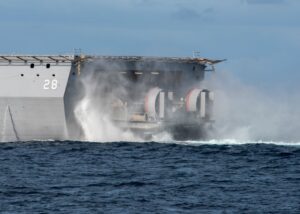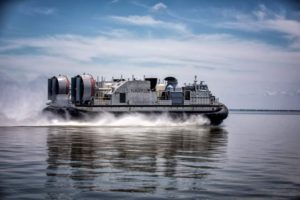The Navy’s latest amphibious transport dock, the future USS Fort Lauderdale (LPD-28), is transporting the new Ship to Shore Connector (SSC) Landing Craft Air Cushions (LCACs) -103 and -104 to their homeport at Norfolk, Va., following the ship commissioning.
LPD-28 is the Navy’s latest amphibious warship and it left the builder’s shipyard, HII’s Ingalls Shipbuilding [HII] at Pascagoula, Miss., on July 11 to sail to its namesake commissioning site in Fort Lauderdale, Fla. The Navy plans to commission it there on July 30 (Defense Daily, July 15).

During Fort Lauderdale’s journey, it worked with Assault Craft Unit (ACU) 4 to have LCAC-103 and -104 enter its well deck on July 16 as a Lift Of Opportunity (LOO) to transport the SSCs to Norfolk, where LPD-28 is ultimately heading as well, following its commissioning.
LCACs-103 and -104 are to remain inside LPD-28’s well deck during the commissioning ceremony and subsequent voyage.
These SSCs were built by Textron Systems [TXT] at its New Orleans shipyard. They were delivered to the Navy in December 2021 and June 2022, respectively. Before being loaded aboard LPD-28, they were at Naval Surface Warfare Center (NSWC) Panama City Division to participate in test and trial events as well as receive post-delivery upgrades.
After the craft are delivered to Norfolk, they will then proceed to ACU 4 in Little Creek, Va., to join LCAC-101 and -102 to continue further post-delivery test and trials and then fleet introduction.
“As the future USS Fort Lauderdale readies for commissioning, the LOO provides the opportunity to further demonstrate a capability that will be essential to the future amphibious fleet for years to come. We welcome the opportunity to bring together key Navy and Marine Corps next generation capabilities as we look to strengthen and advance the amphibious maritime mission,” Capt. Cedric McNeal, program manager of the Amphibious Warfare Program Office, within Program Executive Office (PEO) Ships, said in a statement.

LCAC-100-class craft are built with similar dimensions, clearance and configuration as the legacy LCAC-01 class, so they stay compatible with amphibious vessels with well-decks but feature various improvements. The SSCs are designed for a service life of 30 years and can transport up to 70 tons of personnel, weapons, equipment and cargo at over-the-horizon distances. They are also billed as improving over older LCACs with better engines, higher payloads, smaller crews, and fly-by-wire controls.
The Navy plans to procure up to 72 SSCs. Textron is currently in serial production on LCACs 105-117.
The Navy accepted delivery of LCAC-104 in June, after it completed Acceptance Trials (Defense Daily, June 9).